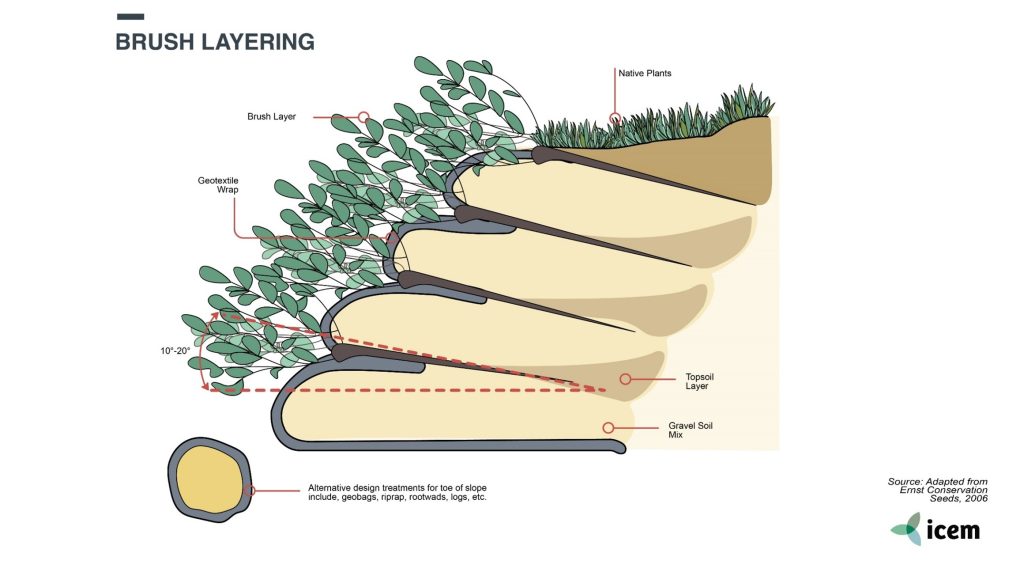| Suburban and urban | Rivers | Medium-cost | Riverbank erosion |
| DESCRIPTION | |
| Measures
|
Brush layering is a method that is used to revegetate and stabilize stream banks and other slopes utilizing horizontal lines of dormant or rooted cuttings covered with layers of soil. It comprises an earthen structure usually wrapped in a natural fabric or geotextile to provide additional reinforcement and is made from live-cut branches or other vegetation mixed with soil and, if used in the toe area of the bank, with rocks. First, a shelf is excavated angled slightly inward towards the bank and following the contour of the slope. The cuttings are then placed in a row or double row, and covered with a layer of soil to a total depth of about a meter and this process is repeated in layers until the top of the bank or slope. The internal composition of the structure can be arranged in such a way as to provide drainage for the bank. |
| Location | Typically brush layering is installed from just below the stream base-flow elevation up the bank face and is often used for the repair or prevention of bank failures due to slip or erosion. It is useful for restoring the outside of bends where erosion is a problem and can produce a well-reinforced, structurally sound river bank. The system incorporates bank reinforcement, drainage, and erosion control and is often applied on steeper slopes where space is limited by adding layers one above the other according to the angle of the bank. |
| Design options and performance | This measure can be used above and below full stream-flow conditions for drainage areas up to 1,000 hectares and in streams with stable streambeds. The construction should be carried out during low flow conditions. Sediment is captured to further stabilize the toe of the streambank. Brush layering is relatively expensive and requires more training and expertise than most other green measures. The system incorporates bank reinforcement, drainage and erosion control and is often applied on steeper slopes where space is limited by adding layers one above the other according to the angle of the bank. |
| Feasibility criteria
|
● Technical design: n/a
● Soil media: n/a ● Soil slope: Can be placed on a 1.1 or steeper slope. ● Surface cover: n/a ● Materials: Rocks, geotextile, cuttings, soil and stakes. |
| Operation and
maintenance |
Once the structure is completed little maintenance is required. A check for scour damage should be made after each rainy season. |
| Cost and benefits | Medium cost measure that provides immediate soil reinforcement enhances conditions for colonization of native vegetation and as vegetation begins to grow, the system becomes increasingly effective in slowing runoff and reducing surface erosion. Roots spread throughout the backfill in each layer and surrounding earth to form a unified mass. Rapid vegetation growth enhances conditions for the colonization of native vegetation. |
| Design solution | A trench is excavated to 0.6 m to 1 m below streambed elevation and about 1 m wide. The geotextile is placed in the trench, leaving a length overhanging on the streamside face to cover the rocks. This trench is filled with small rocks 5cm to 10 cm in diameter and covered with geotextile. Beginning at the full river flow level, a layer of live branch cuttings is placed to a thickness of 15 to 20 cm on top of the rock-filled geogrid with the growing tips at right angles to the streamflow. The base ends of branch cuttings should extend to the back of the excavated slope. This layer of cuttings is then covered with geotextile leaving an overhanging length to cover the soil layer that will be placed next. The 30 cm thick layer of soil, suitable for growing plants, is then placed on top of the geotextile, watered and compacted to ensure good soil contact with the branches. The overhanging portion of the geotextile is then placed over the compacted soil and anchored to the top of the soil using wooden stakes. This process is continued in a sandwich structure by excavating shelves that slope into the bank, placing layers of cuttings and compacted soil wrapped in geotextile until the bank is restored to its original height. Each layer is set back from the one beneath to match the original slope of the bank. The total height of the structure should not exceed 2.5 m, including the part below the stream bed and the length should not exceed 6 m for any one unit along the stream. An engineering analysis should determine the appropriate dimensions of the system. |
| Environmental performance | Brush layering is a technique that effectively prevents soil erosion and stabilizes slopes and river banks. It produces native vegetation, provides fish habitat and re-establishes a healthy riparian zone function. If biodegradable fabric is used no permanent geotextile fabrics are left in the bank. |
| Sources | ● ICEM, 2017. Promoting Climate Resilient Rural Infrastructure in Northern Viet Nam, Technical Report 17: Technical Guidelines for Slope Protection. Prepared for the Ministry of Agriculture and Rural Development and Asian Development Bank. Hanoi.
● LaRiMiT – Norwegian Geotechnical Institute (NGI). 2016. NBS For Erosion Control. ● Mississippi Watershed Management Organization. 2017. A Guide to Bank Restoration Options for Large River Systems: Part II Bioengineering Installation Manual. ● United States Department of Agriculture, Natural Resources Conservation Service. 1996. Engineering Field Handbook – Chapter 16, Streambank and Shoreline Protection. |
Originally developed under the ADB ‘TA-9417 VIE: Secondary Green Cities Development Project – Output 2: Demonstrated sustainable and resilient development in Hue, Ha Giang and Vinh Yen’. Adapted for the UN-CTCN project ‘Climate risk assessment for subnational adaptation and establishment of a local climate information system for climate change adaptation (LISA) in Cambodia’.



